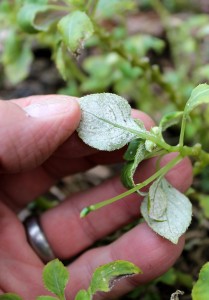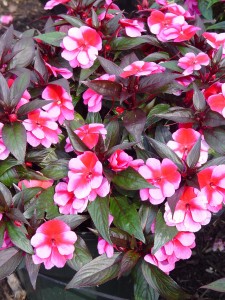Losing Your Impatiens?
April 16th, 2013
People are asking me already about that deadly new downy mildew disease that wiped out just about everyone’s impatiens last year.
I’m not very optimistic that we’re going to escape a repeat this year here in central Pennsylvania.
It’s a highly contagious disease, capable of overwintering, and durable enough to stay active in the soil for 3 to 5 years, the plant pathologists are saying.
Growers are so pessimistic that they’re wondering if they should even bother growing impatiens until we see how it all shakes out.
I’m posting an update on this sordid tale in my weekly Pennlive.com column that’s scheduled to go live April 19. It’ll include a list of my top 10 shade-annual alternatives to impatiens that you might want to try this year. (The column also is to show up in the April 25 edition of The Patriot-News.)
In the meantime, I thought I’d share the assorted questions I’ve been fielding about this new disease.
Q: Where did this come from?
A: The water mold that causes downy mildew has been known since the 1800s, but it didn’t begin devastating garden impatiens in Europe until about 10 years ago.
It’s moved to the United States and has been spreading here since about 2004. It suddenly flared for the first time in central Pa. last summer.
Q: What if my impatiens didn’t get the disease last year. Will I still be able to grow them?
A: You can try, but this disease is extremely contagious. Odds are very good you won’t get away with it again.
Q: My impatiens died last year. Will they be OK if I plant them in a different part of the yard?
A: Unlikely. The disease spreads far and fast by wind and rain. Moving to a different bed nearby will be no big hurdle for it.
Q: How about if I grow them in new soil in a pot?
A: You’ll start out fine, but the odds are good that the disease will get you as well in a pot as in the ground. It just might take a little longer.
Q: Isn’t there anything I can do to prevent it?
A: You might delay infection by not watering the plants overhead or at night and by keeping them as healthy as possible in well drained soil with adequate nutrition.
Wish for hot, dry weather, which slows the disease.
Otherwise, you’re looking at regular and season-long fungicide sprays. And the ones homeowners can buy don’t work very well against this problem anyway. Growers and other licensed applicators can use chemicals that are more effective, which is why you probably will see impatiens that look perfectly healthy at the point of sale.
Q: Will this spread to other flowers?
A: Native jewelweed (closely related) is also very susceptible, but other species outside the impatiens family don’t get this particular strain of mildew-producing pathogen.
So you don’t have to worry about your marigolds, begonias, zinnias, coneflowers and such dying off, too.
New Guinea impatiens and a related series called SunPatiens are apparently resistant to the disease, so those are impatiens-family options still on the table.
Q: What are the symptoms?
A: Growth is stunted. The leaves yellow, wilt and curl. Look on the leaf undersides, and you’ll see a whitish coating. Then the whole plant melts and dies.
Q: What if I plant impatiens and see those symptoms?
A: Yank them ASAP and bag for the trash. Don’t try to compost them. And clean up and bag fallen leaves.
Q: What are YOU doing to do?
A: I’m skipping impatiens until I see what happens.
In the meantime, I’ll be growing more begonias and coleus – and trying things like SunPatiens, browallia, New Guinea impatiens and torenia that I really haven’t planted much before. Now’s a good opportunity to experiment.
Q: Are we done with impatiens for good?
A: I hope not. My guess is breeders eventually will figure out how to overcome this with new disease-resistant introductions.
But for now, it looks like we could be heading toward Europe’s experience.
“Growers there aren’t even listing impatiens in their catalogs anymore,” says Jeanine Standard, a spokeswoman for Sakata Seed America, which produces the mildew-resistant line of SunPatiens.









